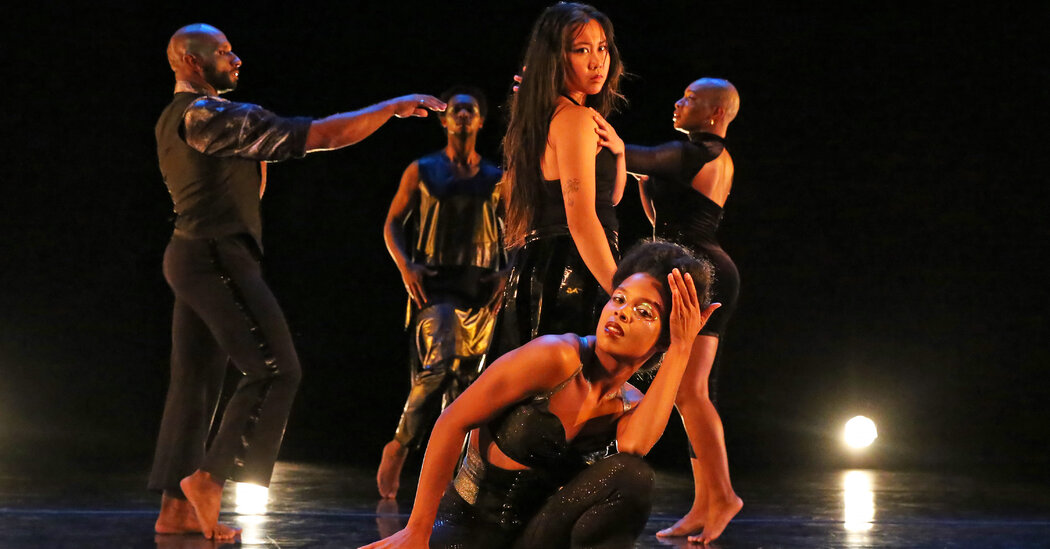Kyle Marshall’s dance “Onyx” has a historical subject: the Black roots of rock ‘n’ roll. But don’t expect the work — one of the three New York premieres that make up his company’s debut program at the Joyce Theater this week — to be a straightforward parade of Black artists and their jukebox hits. Marshall’s approach is exploratory and questioning.
The work features music from the likes of Sister Rosetta Tharpe, but it comes largely in fragments, as from a radio signal barely in range. We first hear bits of James Brown (“The Payback,” nice choice), and then as part of that track plays like a radio fully tuned in, Marshall and his terrific dancers slip into some deliciously funky grooving. Not for long, though. Soon, the music cuts out, setting up a pattern of pleasure flashed and denied.
We hear static and the sound of trains. There’s a physical motif of hands quivering with the spirit. The charismatic dancer Nik Owens, wearing one long glove, samples dances like the Twist and the Mashed Potato before taking a Black Power stance. Then he seems to become Little Richard, whose voice we hear testifying about what the Beatles and the Rolling Stones took from him.
That’s about as direct as “Onyx” gets. Marshall rubs his fingers together in a “pay me” gesture, but that’s just an understated moment during a solo to fragments of Big Mama Thornton’s “Hound Dog” that channels Michael Jackson as much as it does Elvis (who took that song from her). After thrashing to death metal, everyone collapses. But then they rise and the dance carries on, with too many more sections, culminating in a Tina Turner-like turn by Bree Breeden to “I Can’t Stand the Rain.”
The whole program seems to have history on its mind. “Alice,” a stand-alone piece for Breeden set to three spiritual compositions by Alice Coltrane, looks like a descendant of Alvin Ailey’s “Cry,” a classic one-woman work that also uses Coltrane’s music. “Alice” is an old-fashioned modern-dance solo, complete with penitent kneeling and diagonal walks into the light, but it’s a less dramatic affair than “Cry,” more gently self-accepting. Breeden is excellent in it, undulant and calmly strong, making blooming jumps land softly and melt into the floor.
“Ruin,” which opens the program, is weakest, showing the downsides of Marshall’s take-your-time approach. The dancers are attired (by Edo Tastic, the company’s creative director) as Greek statues with heavy eyeliner and mini hair buns. They move like Greek statues, too, on a stage littered with electronic equipment and urns.
The electronics and urns have something to do with a Dynamic Listening system, designed by Cal Fish, who controls it from in front of the stage. But the stage sounds that Fish loops and manipulates — the clapping, snapping and stepping of the dancers — are too rhythmically rudimentary. As in “Onyx,” the grooves keep being interrupted, like an avoidance of rhythm. Late in the dance, more contemporary looseness and attitude seep into the movement, and I imagined that the statues were waking up and acquiring color. This notion faded, though, as the crackling of fire became the white noise of rain.
“Onyx,” in its way, is also about ruin, or ruins. The static that interrupts the music is the sound of erasure. But “Onyx” is more hopeful and touching in its attitude toward the past. Some of its movement phrases look like those of Trisha Brown, in whose company Marshall danced. At the end, we hear the voice of Thornton reminding us that “old-timers” still have something to say, and the dancers look back respectfully at an empty patch of light. As they exit, Breeden’s gaze lingers on a shadow on the wall.
Kyle Marshall Choreography
Through Sunday at the Joyce Theater in Manhattan; joyce.org.


